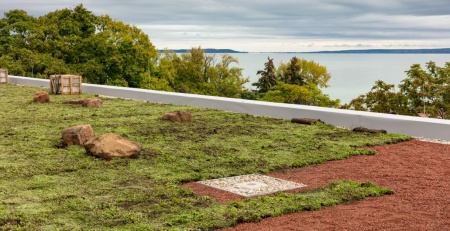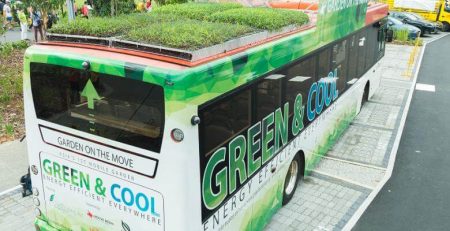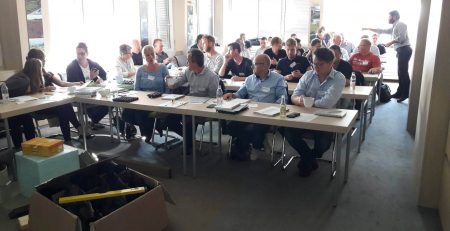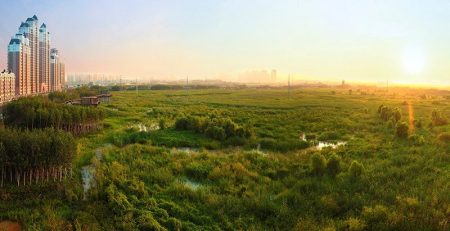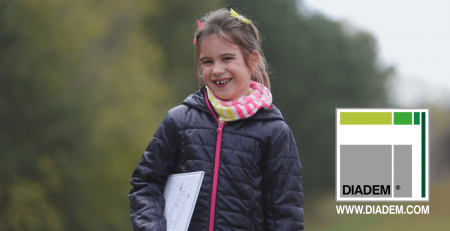News of the Green roof-World – Australia
It’s a bold vision for Australia’s future. The grey roofs of city buildings transformed into a green canopy.
City councils — including Sydney and Melbourne — have been nurturing the green roof concept for about a decade. But progress has been slow.
Researchers have now published new data further measuring the benefits of these gardens in the sky in the hope that more developers and property owners will take up the idea.
The University of Melbourne’s Dr Claire Farrell said her team found a 10-centimetre-deep substrate could absorb up to 95 per cent of annual rainfall in Melbourne. “They act like a sponge,” she said. “They keep that rainfall from going into creeks and rivers where they cause a lot of damage and carry pollutants.” She said Melbourne was helped by its “four seasons in one day” because light showers gave roof gardens the best chance of soaking up moisture.
The benefits of capturing run-off also extend to flood prevention. “As cities become more dense, we’re getting more and more rooftops and more impervious surfaces,” Dr Farrell said. “[It] can lead to flash flooding when we have big events in a short period of time.”


PHOTO: Associate Professor Nick Williams shows off the University of Melbourne’s green roof which thrives in a specially designed substrate.
Associate Professor Nick Williams said green roofs also helped to lower heating and cooling costs. Modelling for a single-storey brick office with a concrete roof shows potential savings of up to 65 per cent in heating and up to 35 per cent in cooling bills.
But what about a huge office tower?
“For energy savings by itself, you wouldn’t add a green roof,” he said. “It’d be cheaper to add additional insulation to your building.”
But he said when considering all the benefits, green roofs presented a compelling case. “Energy and stormwater and biodiversity and human productivity benefits from looking out on a green space.”
“Then the value of green roofs really comes to the fore.”
The researchers said environmental and economic benefits would be similar for buildings in Adelaide and Sydney where the climate was not completely unlike Melbourne’s.
But the precise findings for all Australian cities are yet to be established using the university’s methodology.


Green roofs a ‘no brainer’ for developers
However, an inner-city oasis does not come cheap. That is why the researchers have recommended government incentives to boost the industry.
They could include fast-tracked building approvals, relaxed height restrictions or financial grants, according to Paolo Bevilacqua from Frasers Property.
“It would be great to see some kind of government incentives in this space,” Mr Bevilacqua said. “Humans just love connecting to nature — in that respect it’s a bit of a no brainer.”


PHOTO: One Central Park in Sydney is covered in about 35,000 plants.
The developer helped build One Central Park in the Sydney suburb of Chippendale, with “living walls” and roofs covered in plants.
Mr Bevilacqua said green roofs and walls make commercial sense for developers. “Any point of difference can help sell,” he said. “The green aspects were definitely a key part and definitely helped the sell.”
Councillor says progress has been ‘too slow’
Green roofs are far more common in North America and Europe.
Toronto has a bylaw requiring green roofs on developments with a floor area greater than 2,000 square metres.
The measure is currently being considered in Melbourne to encourage green roofs and walls, along with other regulatory changes and incentives.
The Victorian Government and the City of Melbourne are close to finalising a public site for a demonstration green roof.
But Melbourne Councillor Cathy Oke said the administration’s powers were limited, with the pace of change largely in private hands.
“We can’t green the roofs that we don’t own,” she said. “Progress has definitely been too slow”


PHOTO: Melbourne’s skyline as it is currently — concrete as far as the eye can see. (ABC News: Margaret Burin)
On the city council’s count, there are currently about 40 green roofs in the central Melbourne area. The City of Sydney’s list shows about 60 green roofs — including at the New South Wales Parliament and the ABC’s Ultimo Headquarters.
Cathy Oke said the potential in Melbourne was huge considering the council had identified more than 400 hectares of roof space that could be suitable for green roofs.
“This is the equivalent to five times the size of Royal Park that we could have on roofs in Melbourne,” she said.
Source: https://www.abc.net.au/news/2018-05-20/why-australia-needs-more-rooftop-gardens/9775464

